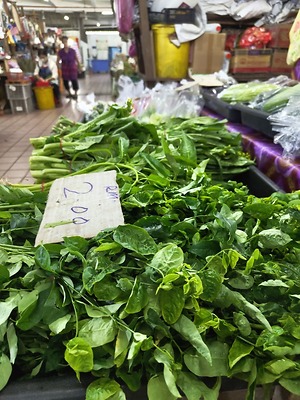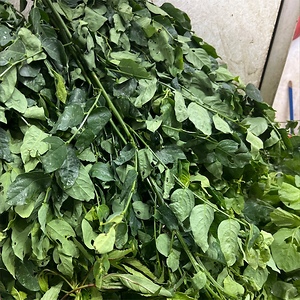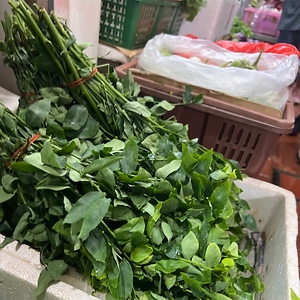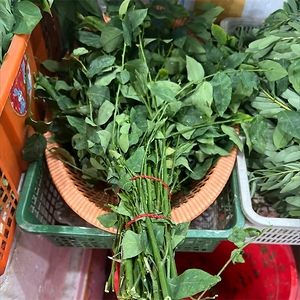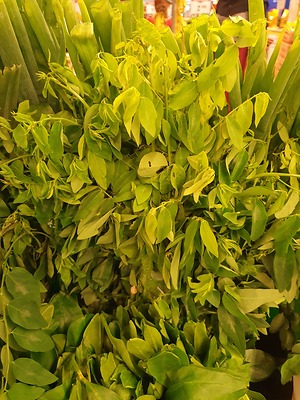


Sayur Manis Leaves
Estimated Inventory, lb : 0
Description/Taste
Sayur Manis leaves are small and elongated to oval in shape, averaging 4-6 centimeters in length. The dark green leaves grow in an alternate pattern and are smooth, thin, and taper to a rounded and blunt point. Sayur Manis leaves grow on stems that are thick and fibrous at the base and then narrow to a flexible stem at the top where the leaves grow. The most tender parts of the plant are the top four or five inches of the branch tip, which have a slightly sweet and nutty flavor, reminiscent of fresh garden peas. When cooked, Sayur Manis leaves have a mild, sweet, green flavor similar to asparagus and offer a slightly acidic bite, also similar to spinach. The plant does flower, with small rose to carmine color blossoms, and bears white-pinkish fruit with black seeds.
Seasons/Availability
Sayur Manis leaves are available year-round.
Current Facts
Sayur Manis leaves, botanically classified as Sauropus androgynous, grow on a perennial shrub that can reach 2-3 meters in height and are members of the Phyllanthaceae family. Also known as the Sabah vegetable, Katuk, Cekur Manis and Sayur Manis in Malay, Mani Cai in Chinese, Pak Waan in Thai, Amame Shiba in Japanese, and Sweet leaf and Star gooseberry in English, Sayur Manis leaves are extremely popular in Southeast Asia and are known for their flavor as "Manis" means "sweet", while "sayur" means "vegetable". It is important to note that Sayur Manis leaves contain a certain amount of oxalic acids that can prove to be toxic when consumed in large amounts and they must be cooked before consumption.
Nutritional Value
Sayur Manis leaves contain iron, antioxidants, calcium, and vitamins A, C, E, and K.
Applications
Sayur Manis leaves must be cooked before consumption and are best suited for applications such as sautéing, stir-frying, and boiling. They are commonly added in stir-fries with fried eggs or belacan, a dried shrimp paste. They are also used as a leafy vegetable in noodle soups such as Pan Mee or Mee Hoon Kuih, which are anchovy-base soups popular in Malaysia. Though both the stem and the leaves are edible, the stems can be fibrous and chewy. The leaves are most commonly consumed portion and can easily be separated by holding the stem at one end and pushing down with a thumb and index finger. They should also be washed in a salt and water bath to remove bitterness prior to cooking. Sayur Manis leaves pair well with eggs, dried anchovies, pork, crab, red peppers, and aromatics such as shallots, garlic, onion, and ginger. They will keep for a couple of days when stored fresh in the refrigerator.
Ethnic/Cultural Info
Sayur Manis leaves are native to Southeast Asia and have been growing wild since ancient times. They were first commercially cultivated in Sabah, a Malaysian state on Borneo Island. Today Sayur Manis leaves are still predominately located in their native region and can be found at fresh markets in regions across Southeast Asia.
Geography/History
Sayur Manis leaves are native to Southeast Asia and have been growing wild since ancient times. They were first commercially cultivated in Sabah, a Malaysian state on Borneo Island. Today Sayur Manis leaves are still predominately located in their native region and can be found at fresh markets in regions across Southeast Asia.
Recipe Ideas
Recipes that include Sayur Manis Leaves. One



